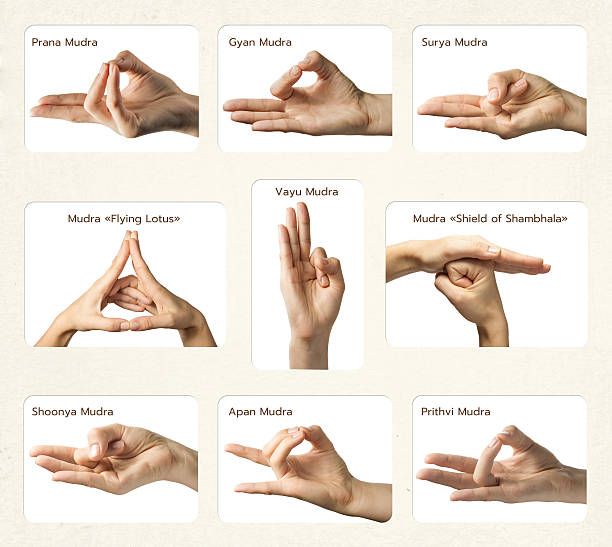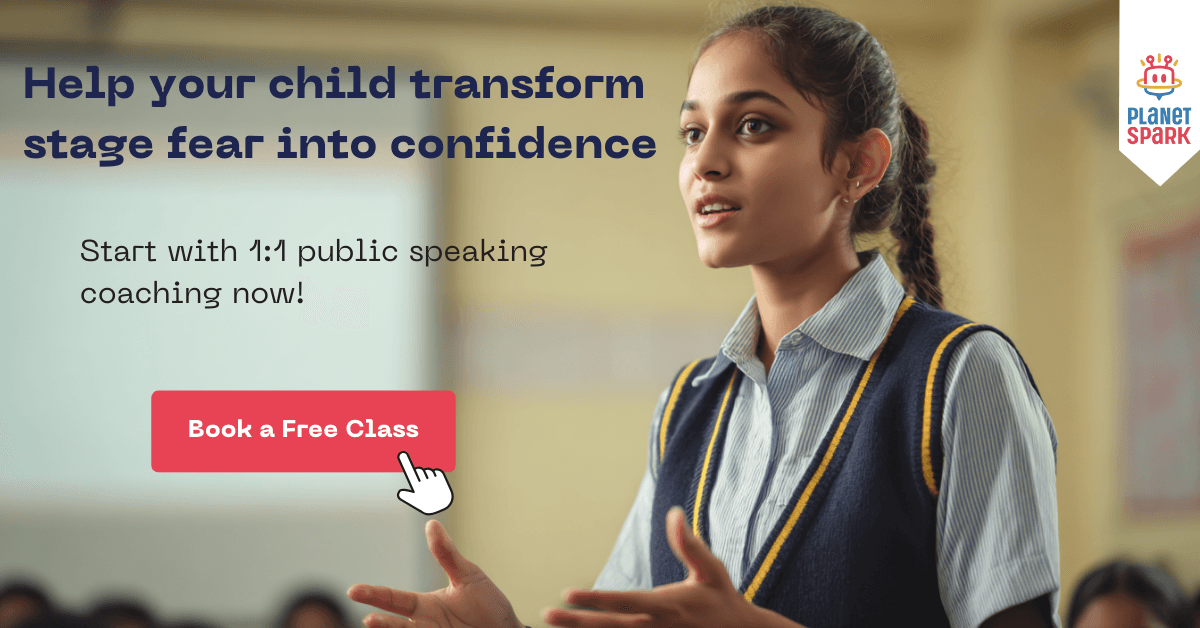How to Be Confident: 16 Tips for Kids to Speak Boldly

Table of Contents
Confidence isn't something you're born with; it's something you build over time. Whether it’s raising a hand in class, introducing oneself to new people, participating in a debate, or speaking on stage, confidence plays a crucial role in helping children and teens express themselves, take initiative, and handle life’s challenges.
In this comprehensive guide, we explore 16 actionable, research-backed strategies to build confidence in children and teens, especially in communication and public speaking. We’ll also dive deep into body language techniques, situation-specific tips, and even hand mudras to channel inner calm and strength.
16 Confidence-Building Strategies for Children and Teens
1. Speak Daily to Build Verbal Courage
Speaking is like working a muscle, the more it's used, the stronger it becomes. Daily conversations about their day, reading aloud, or explaining a concept can go a long way in reducing hesitation. Tools like voice recording or short video presentations help with self-review and expression.
Encourage your child to explain what they learned in school or summarize a movie they watched. These everyday speaking opportunities help reduce shyness and strengthen vocabulary.
2. Break Big Challenges Into Small Wins
Instead of setting overwhelming goals like "speak for five minutes on stage," begin with telling a short story to a sibling. Gradually increase the difficulty, family, friends, classroom, and celebrate each step to strengthen self-belief.
Use a staircase metaphor: every small speaking task is a step toward the final goal. Recognize each achievement with applause or a sticker chart to keep momentum alive.
3. The Mirror Method
Mirror practice boosts self-awareness and confidence. Ask children to rehearse speeches in front of a mirror and observe their expressions, gestures, and eye contact. Reflection questions like “Was I too fast?” or “Did I smile?” help refine delivery.
This also helps children develop comfort with seeing themselves speak, which reduces self-consciousness. Let them practice with fun topics like “My favorite animal” to build ease.
4. Power Poses and Posture Hacks
Body posture influences mental state. Teach your child to stand tall, maintain open posture, and use "power poses" like the superhero stance (hands on hips, feet apart). This instantly boosts presence and self-assurance.
Incorporate these poses into daily routines, for example, do a 2-minute superhero pose before leaving for school or before a presentation.
5. Use Positive Affirmations
Daily affirmations like “I am a confident speaker,” “I express myself clearly,” or “It’s okay to make mistakes” instill a growth mindset. Place them on mirrors, notebooks, or say them together as a routine.
You can even turn affirmations into songs or rhymes to make them more engaging for younger kids. Repetition strengthens belief.
6. Let Them Make Decisions
Confidence grows in environments that respect autonomy. Let your child pick topics to present, choose outfits, or decide the sequence of activities. These small choices build decision-making confidence.
Start with daily choices like breakfast selection or weekend plans, and gradually expand to presentation topics and extracurricular interests.
7. Roleplay Real-Life Scenarios
Mock situations like giving a school speech, introducing themselves to new relatives, or answering an interview question prepare them mentally. Roleplaying reduces anxiety and builds spontaneity.
Make it playful, use props, assign roles, and create fun characters to make the activity light and engaging. Reward effort over outcome.

8. Join Speaking Platforms and Challenges
Consistent exposure is key. Encourage participation in debates, storytelling contests, or school presentations. Online platforms and clubs like PlanetSpark offer structured environments for practice.
Look for local elocution events, or ask your child to present a weekend story to the family. These moments build readiness for formal settings.
9. Reflect Over Perfecting
Focus on progress rather than perfection. Ask reflective questions post-activity: "What went well?" and "What can I improve?" This approach normalizes learning and enhances resilience.
Use a confidence diary where your child notes how they felt before and after speaking, helping them see improvement over time.
10. Track Progress Visually
Create a progress chart to record speaking opportunities, confidence scores, and feedback. Apps like the Spark Diary or homemade visual boards keep motivation high.
Let your child decorate their progress chart with stars, smiley stickers, or even drawings. Visualization encourages continued effort.
11. Gamify the Journey
Introduce points or rewards for confidence milestones:
- Introducing themselves: 5 points
- Asking a question in class: 10 points
- Leading a group activity: 20 points Make confidence-building fun and measurable.
Turn this into a leaderboard challenge with siblings or friends to add some healthy competition. Celebrate monthly “confidence champions.”
12. Normalize Mistakes
Show your child that making mistakes is okay. Share bloopers from speeches or examples of public figures who failed before they succeeded. Growth lies in resilience.
Tell stories of your own awkward moments and how you bounced back. Children love relatable examples that prove perfection isn’t necessary.
13. Choose Positive Influences
Confidence thrives in supportive environments. Enroll children in programs or clubs where effort is celebrated and feedback is constructive.
Surround them with uplifting peers, mentors, or older kids they admire. Avoid negative or overly critical influences.
14. Model Confidence Yourself
Parents and mentors must model calm, confident behavior. Share your own nervous moments and how you overcame them to show that confidence is cultivated.
Speak clearly at home, show comfort while talking to strangers, and let children see how you handle criticism constructively.
15. Involve the Family
Family plays a crucial role. Applaud every small win, attend their events, ask questions about their speeches, and create an atmosphere of encouragement.
Start a family tradition like “Saturday Story Circle” where each member speaks for a minute on any topic. This builds camaraderie and speaking fluency.
16. Encourage Storytelling
Storytelling boosts creativity, memory, and verbal fluency. Ask children to narrate their day, invent stories, or describe past events to enhance self-expression.
Mastering Confident Body Language
Body language is often more powerful than spoken words. It can either reinforce your child’s message, or completely contradict it. When children master confident body language, they don’t just look more assured, they actually start to feel more assured. That’s the magic of non-verbal communication: it shapes not just how others see us, but how we see ourselves.
This section will explore everything a child (and parent) should know about using body language to project self-confidence in school, social settings, or on stage.
1. Why Body Language Matters for Confidence
Children don’t always know how much they’re “saying” with their bodies. Slouched shoulders, fidgeting, avoiding eye contact, these signs can unintentionally signal nervousness or lack of interest, even when the child is prepared and capable.
Confident body language, on the other hand:
Makes a child appear more credible and in control.
Increases their chances of being heard and respected.
Boosts internal self-assurance through positive posture and movement.
Research shows that non-verbal cues make up over 60% of communication. That means your child’s posture, gestures, and facial expressions often speak louder than their word
2. The Foundation: Posture
Teach your child that posture is the first impression.
A confident posture involves:
Standing tall with shoulders relaxed but not slouched.
Keeping the back straight and chin up, not too high to seem arrogant, not too low to seem timid.
Grounding the feet shoulder-width apart when standing.
Avoiding leaning on one leg or constantly shifting weight.
Good posture creates a strong base for breathing clearly and projecting the voice - both critical for speaking confidently in public.
3. Eye Contact: The Confidence Connector
Eye contact is one of the strongest indicators of self-assurance and trustworthiness.
For children, especially introverts, maintaining eye contact can feel intimidating. But it can be taught gently:
Ask them to look at the forehead or nose bridge of a person if direct eye contact feels uncomfortable.
Practise with family: hold eye contact during dinner conversations.
Encourage “Z-pattern” scanning when addressing a group left, center, right - to appear inclusive.
Even 3–5 seconds of consistent eye contact can convey boldness, sincerity, and attentiveness.
4. Facial Expressions: Let the Face Match the Message
A monotone face while delivering an exciting story sends mixed signals. Facial expressions should match the tone and content of what your child is saying.
Key expressions to practise:
Smiling at the beginning and end of a conversation or speech to show warmth.
Eyebrow movement to express curiosity or emphasis.
Eye widening slightly when telling a surprising fact.
Relaxed jaw and cheeks - tension in the face signals anxiety.
The goal is natural, expressive facial movement, not forced smiles. Start by letting kids narrate stories in front of a mirror and observe how their face reflects different emotions.
5. Hand Gestures: Amplify the Words
Gestures make communication dynamic and memorable. Children who use hand gestures while speaking tend to appear more engaged and passionate.
Encourage:
Open palm gestures to show honesty.
Upward hand movements to emphasize a point.
Controlled motion, not too stiff, not too wild.
Avoid:
Hands in pockets (signals disinterest).
Pointing fingers (can appear aggressive).
Clutching notes too tightly (shows nervousness).
One simple exercise is asking your child to explain “how to make a sandwich” using both words and gestures. This creates awareness of natural hand movement.
6. Head Movements and Nod Patterns
Head movement is often overlooked, but it plays a big role in body language.
Nodding while listening shows attentiveness and agreement.
Tilting the head slightly while asking a question adds warmth and engagement.
Keeping the chin level during speech shows confidence, tilted too high appears arrogant, too low appears unsure.
Children can practise nodding with intention in casual conversations to build habit.
7. Movement and Spatial Awareness
Confident speakers move with purpose, not panic.
Teach your child to:
Walk calmly to a speaking spot, no rushing.
Shift slightly while transitioning between ideas, but avoid pacing.
Stand still during main points, as stillness adds impact.
8. Controlling Fidgeting and Nervous Tics
Many children develop unconscious habits when nervous, like tapping feet, biting nails, playing with their clothes, or shifting from side to side.
To manage this:
Replace fidgeting with controlled gestures.
Use a “grounding object” like a small stress ball backstage, but not during the performance.
Encourage deep breathing and visualization exercises before speaking.
Fidgeting is not a flaw, it’s a sign of nervous energy that can be redirected into powerful gestures.
9. The Pre-Speech Confidence Ritual
Help your child build a simple, 2-minute ritual before going on stage or speaking:
Power pose for 30 seconds (hands on hips, superhero stance).
Smile at themselves in the mirror.
Recite one or two affirmations.
Take three deep breaths while standing tall.
This sequence not only grounds them physically but mentally prepares them to lead the moment.
10. Body Language in Virtual Settings
In today’s digital age, body language matters just as much on screen.
For online classes or interviews:
Ensure the camera captures the upper half of the body.
Sit up straight, with eyes at camera level.
Maintain expressive facial cues and hand gestures even through
Hand Mudras to Channel Inner Calm and Strength
Mudras are symbolic hand gestures used in Indian traditions to guide energy flow. Some mudras are known to reduce anxiety and boost focus, making them perfect pre-speech rituals:

1. Gyan Mudra (Gesture of Knowledge)
How it's done: Touch the tip of the index finger to the thumb; other fingers extended.
Used when: Emphasizing a thoughtful or insightful point.
Effect: Suggests calm wisdom, mental clarity, and balance. Often used subtly in a seated discussion or slow-paced delivery.
2. Abhaya Mudra (Gesture of Fearlessness)
How it's done: Palm facing out, fingers upright — like a “stop” gesture.
Used when: Reassuring the audience, calming them, or conveying trust and safety.
Effect: It exudes authority with warmth, commonly seen in leaders calming tense crowds or during heartfelt statements.
3. Prana Mudra (Gesture of Vital Energy)
How it's done: Thumb touches the tips of the ring and little finger.
Used when: Talking about inner strength, enthusiasm, or action.
Effect: Communicates hidden energy, vitality, and determination. Great for inspiring action or motivation.
4. Steeple Gesture
How it's done: Fingertips of both hands touch, palms apart, forming a “steeple.”
Used when: Confidently explaining something or answering a question with authority.
Effect: This is a classic confidence and control gesture. Top executives often use this in interviews or on stage.
5. Open Palm Gesture
How it's done: Hands at waist height, palms facing up or slightly outward.
Used when: Explaining, offering ideas, or building rapport.
Effect: Signals openness, honesty, and engagement. It invites the listener in and reduces defensiveness.
6. Precision Grip
How it's done: Thumb and index finger form a small circle (like holding a small object), other fingers relaxed.
Used when: Highlighting a specific or precise idea.
Effect: Makes you appear focused and deliberate. Ideal for breaking down complex thoughts into sharp points.
How to Be Confident in Different Situations
Confidence manifests differently depending on the situation. Here are specific tips for common scenarios:
1. In Interviews
- Practice common questions: Tell me about yourself, what are your hobbies, etc.
- Use the STAR method (Situation, Task, Action, Result) for structured answers
- Encourage calmness through slow breathing before entering
2. In Group Discussions or Debates
- Listen actively to others
- Keep rebuttals logical and calm
- Start small at home and build up to classroom debates
3. With Relatives or Strangers
- Begin with greetings and short conversations
- Teach them to introduce themselves confidently: "Hi, I’m Riya, I study in Class 5."
- Encourage asking polite questions in return
4. With Peers
- Promote participation in group games or school clubs
- Let them take turns as team leaders or presenters
- Celebrate each leadership act
Tricks to Control Nervousness on Stage
Stage fright is natural, even the most experienced speakers feel it. But for kids and teens, the fear of speaking in front of others can be overwhelming. The good news is that nervousness isn’t a sign of weakness, it’s a sign that you care. And with the right techniques, children can transform those jittery nerves into focused energy.
Here are some powerful, practical tricks to control nervousness before and during a stage performance:

1. Practise Like It’s the Real Thing
One of the biggest sources of nervousness is the fear of the unknown. Simulate the performance environment as closely as possible:
Practise the speech standing up.
Rehearse with a microphone or hairbrush.
Have a parent or sibling act as the “audience.”
The more familiar the setting feels, the less scary it becomes. Confidence grows with repetition.
2. Visualize Success, Not Mistakes
Visualization is a mental trick used by athletes, performers, and public speakers. Instead of imagining things going wrong, ask your child to picture themselves succeeding:
Standing tall.
Speaking clearly.
Smiling at the audience.
Receiving applause.
This mental movie prepares the brain to believe in that outcome.
3. Control the Breath, Control the Mind
Shallow breathing fuels anxiety. Before going on stage, teach your child the 4–7–8 breathing technique:
Inhale for 4 seconds
Hold for 7 seconds
Exhale for 8 seconds
Repeat this two or three times. It slows the heart rate and reduces physical signs of nervousness like shaking hands or dry mouth.
4. Use a “Launch Line”
The scariest moment is often the first sentence. Help your child memorise a strong opening line, a greeting, a question, or a fun fact. This “launch line” becomes an anchor that gets them into the flow.
For example:
A confident start can eliminate hesitation and build immediate momentum.
5. Shift the Focus from Self to Audience
Remind your child: The speech isn’t about them, it’s about the message and the people listening.
When children focus on helping, teaching, or entertaining others, their nervousness fades. Encourage them to think:
“How can I make the audience feel excited or inspired?”
This mindset shift can dramatically reduce stage anxiety.
6. Keep a Water Bottle Nearby
Dry throat is a common symptom of nervousness. A quick sip of water before going on stage keeps the throat moist and gives a small moment to reset.
Bonus: Holding the bottle backstage can provide a comforting tactile focus (a “prop” that calms the nerves).
7. Fake It Until You Feel It
Even if your child doesn’t feel confident, they can act it out.
Smile. Stand tall. Use expressive hand gestures. Speak slowly. The audience won’t know the difference, and soon enough, the act of looking confident helps your child actually feel that way.
8. Accept Nervousness as Normal
Don’t try to eliminate nerves entirely, normalize them. Share stories of how famous speakers and actors still feel nervous. Let your child know:
“It’s okay to feel scared. What matters is that you speak anyway.”
This helps reframe nerves as part of the process, not a sign of failure.
9. Use a Confidence Trigger
Give your child a special object or phrase to carry or repeat before speaking. It could be:
A lucky pen or bracelet.
A phrase like “I’ve got this!” or “Let’s shine!”
These triggers become personal rituals that provide comfort and strength on stage.
10. Debrief After Every Performance
After speaking, don’t jump straight to critique. First, ask:
“What felt good?”
“What part were you proud of?”
“How did it feel when the audience clapped?”
This helps rewire their brain to associate public speaking with positive emotions, making the next time even easier.
How PlanetSpark Helps Build Confidence in Kids
At PlanetSpark, we believe that every child has the potential to be a confident communicator. Our programs are designed to offer:
- Live 1:1 Coaching: Personalized guidance tailored to the child's pace
- Creative Modules: Storytelling, debates, JAM sessions, extempore speaking
- Real-Life Stage Exposure: SparkX events and competitions
- Feedback Tools: Spark Diary, Leaderboards, Confidence Tracker
- Mentorship and Peer Community: Safe, positive environments to grow
Whether your child is shy, unsure, or already expressive, PlanetSpark mentors guide them step-by-step to unlock their speaking potential.
From whispers to winning speeches, confidence begins with the first step. 👉 Book Your Free Trial Class with PlanetSpark Now
Conclusion: Confidence is a Lifelong Skill
Building confidence in children is not a one-time event, it’s a journey of consistent practice, reflection, and encouragement. Through daily speaking, structured coaching, and supportive environments, every child can grow into a poised, expressive communicator.
Frequently Asked Questions (FAQs)
1. How to be confident while speaking in public?
Practice regularly, focus on your message rather than your fear, and use tools like deep breathing, mirror speaking, and rehearsals to build familiarity and reduce anxiety.
2. How can I help my child learn how to be confident in school?
Encourage participation in class activities, let them express their opinions at home, and enroll them in programs like PlanetSpark to get structured support.
3. What are the best ways to teach kids how to be confident speakers?
Use roleplays, storytelling, and structured feedback. Celebrate progress and normalize mistakes to help them grow.
4. How to be confident around new people or relatives?
Start with simple greetings and small talk. Practice short introductions at home and gradually increase social exposure.
5. Can body language help in learning how to be confident?
Absolutely. Maintaining eye contact, upright posture, and open hand gestures significantly improve the way others perceive you and how you feel internally.
6. How to be confident on stage during competitions or speeches?
Prepare thoroughly, visualize success, and use power poses beforehand. Repeated stage exposure is key.
7. What are the top techniques for how to be confident in interviews?
Prepare answers in the STAR format, dress appropriately, smile, and use calm, slow speech with thoughtful pauses.
8. Are there hand mudras that teach how to be confident?
Yes, mudras like Gyan Mudra, Prana Mudra, and Abhaya Mudra can help calm nerves and build inner strength before speaking.
9. How can a shy child learn how to be confident in group discussions?
Begin with family discussions, move to classroom participation, and gradually expose them to debates or clubs.
10. What role does PlanetSpark play in helping kids learn how to be confident?
PlanetSpark offers 1:1 coaching, speaking challenges, feedback tools, and a positive environment tailored to help every child develop communication confidence.
Personalized Communication Report
Record a video to get a AI generated personalized communication report for your child

Hi There, want to try these
tips for your child with
LIVE with our expert coach?
Let's check your child's
English fluency
